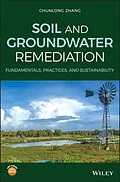An introduction to the principles and practices of soil and groundwater remediation
Soil and Groundwater Remediation offers a comprehensive and up-to-date review of the principles, practices, and concepts of sustainability of soil and groundwater remediation. The book starts with an overview of the importance of groundwater resource/quality, contaminant sources/types, and the scope of soil and groundwater remediation. It then provides the essential components of soil and groundwater remediation with easy-to-understand design equations/calculations and the practical applications.
The book contains information on remediation basics such as subsurface chemical behaviors, soil and groundwater hydrology and characterization, regulations, cost analysis, and risk assessment. The author explores various conventional and innovative remediation technologies, including pump-and-treat, soil vapor extraction, bioremediation, incineration, thermally enhanced techniques, soil washing/flushing, and permeable reactive barriers. The book also examines the modeling of groundwater flow and contaminant transport in saturated and unsaturated zones. This important book:
* Presents the current challenges of remediation practices
* Includes up-to-date information about the low-cost, risk-based, sustainable remediation practices, as well as institutional control and management
* Offers a balanced mix of the principles, practices, and sustainable concepts in soil and groundwater remediation
* Contains learning objectives, discussions of key theories, and example problems
* Provides illustrative case studies and recent research when remediation techniques are introduced
Written for undergraduate seniors and graduate students in natural resource, earth science, environmental science/engineering, and environmental management, Soil and Groundwater Remediation is an authoritative guide to the principles and components of soil and groundwater remediation that is filled with worked and practice problems.
Autorentext
CHUNLONG (CARL) ZHANG is a professor of environmental science at the College of Science and Engineering, University of Houston-Clear Lake, and a registered professional engineer (PE) in the field of environmental engineering. A noted expert in environmental remediation, he is also the author of the popular textbook Fundamentals of Environmental Sampling and Analysis published by Wiley.
Klappentext
AN INTRODUCTION TO THE PRINCIPLES AND PRACTICES OF SOIL AND GROUNDWATER REMEDIATION
Soil and Groundwater Remediation offers a comprehensive and up-to-date review of the principles, practices, and concepts of sustainability of soil and groundwater remediation. The book starts with an overview of the importance of groundwater resource/quality, contaminant sources/types, and the scope of soil and groundwater remediation. It then provides the essential components of soil and groundwater remediation with easy-to-understand design equations/calculations and the practical applications.
The book contains information on remediation basics such as subsurface chemical behaviors, soil and groundwater hydrology and characterization, regulations, cost analysis, and risk assessment. The author explores various conventional and innovative remediation technologies, including pump-and-treat, soil vapor extraction, bioremediation, incineration, thermally enhanced techniques, soil washing/flushing, and permeable reactive barriers. The book also examines the modeling of groundwater flow and contaminant transport in saturated and unsaturated zones. This important book
- Presents the current challenges of remediation practices
- Includes up-to-date information about the low-cost, risk-based, sustainable remediation practices, as well as institutional control and management
- Offers a balanced mix of the principles, practices, and sustainable concepts in soil and groundwater remediation
- Contains learning objectives, discussions of key theories, and example problems
- Provides illustrative case studies and recent research when remediation techniques are introduced
Written for undergraduate seniors and graduate students in natural resource, earth science, environmental science/engineering, and environmental management, Soil and Groundwater Remediation is an authoritative guide to the principles and components of soil and groundwater remediation that is filled with worked and practice problems.
Inhalt
About the Author xv
Preface xvii
Acknowledgments xxi
Whom This Book is Written For xxiii
To the Instructor xxv
List of Symbols xxvii
About the Companion Website xxxiii
1 Sources and Types of Soil and Groundwater Contamination 1
1.1 Uses of Surface Water vs. Groundwater 1
1.2 Groundwater Quantity vs. Groundwater Quality 4
1.3 Major Factors Affecting Groundwater Quality 6
1.4 Soil and Groundwater Contaminant Sources in the United States 8
1.4.1 Superfund Sites and Brownfields 9
1.4.2 RCRA Facilities and Underground Storage Tanks 12
1.4.3 DoD/DoE Sites 14
1.5 Contaminated Soil and Groundwater: A Global Perspective 14
1.6 Soil and Groundwater Remediation 16
1.6.1 Unique Challenges Relative to Air and Surface Water Pollution 16
1.6.2 Scope of Environmental Remediation 17
Bibliography 17
2 Subsurface Contaminant Fate and Transport 21
2.1 Frequent Soil and Groundwater Contaminants 22
2.1.1 Aliphatic and Aromatic Hydrocarbons 23
2.1.2 Halogenated Aliphatic Hydrocarbons 24
2.1.3 Halogenated Aromatic Hydrocarbons 25
2.1.4 Nitrogencontaining Organic Compounds 26
2.1.5 Oxygenated Organic Compounds 27
2.1.6 Sulfur and Phosphoruscontaining Organic Compounds 28
2.1.7 Inorganic Nonmetals, Metals, and Radionuclides 29
2.2 Abiotic and Biotic Chemical Fate Processes 30
2.2.1 Hydrolysis 31
2.2.2 Oxidation and Reduction 32
2.2.3 Biodegradation 35
2.3 Interphase Chemical Transport 35
2.3.1 Volatilization 36
2.3.2 Solubilization, Precipitation, and Dissolution 38
2.3.2.1 Solubility and Solubility Product for Inorganic Compounds 38
2.3.2.2 Solubility and Kow for Organic Compounds 41
2.3.3 Sorption and Desorption 42
2.4 Intraphase Chemical Movement 48
2.4.1 Advection 49
2.4.2 Dispersion and Diffusion 49
Bibliography 53
3 Soil and Groundwater Hydrology 59
3.1 Soil Composition and Properties 60
3.1.1 Constituents of Soils 60
3.1.2 Soil Physical and Chemical Properties 62
3.2 Basic Concepts of Aquifer and Wells 66
3.2.1 Vertical Distribution of Aquifer 66
3.2.2 Groundwater Well and Well Nomenclature 68
3.2.3 Hydrogeological Parameters 68
3.2.3.1 Specific Yield and Specific Retention 68
3.2.3.2 Hydraulic Conductivity and Permeability 70
3.2.3.3 Transmissivity and Storativity 71
3.3 Groundwater Movement 73
3.3.1 Flow in Saturated Zone 74
3.3.2 Flow in Unsaturated Zone 77
3.3.3 Flow to Wells in a SteadyState Confined Aquifer 80
3.3.4 Flow to Wells in a Steady-State Unconfined Aquifer 82
3.3.5 Flow of Nonaqueous Phase Liquid 84
Bibliography 86
4 Legal, Economical, and Risk Assessment Considerations 91
4.1 Soil and Groundwater Protection Laws 92
4.1.1 Relevant Soil and Groundwater Laws in the United States 92
4.1.1.1 Safe Drinking Water Act 93
4.1.1.2 Resource Conservation and Recovery Act 94
4.1.1.3 Comprehensive Environmental Response, Compensation and Liability Act 95
4.1.1.4 Hazardous and Solid Waste Amendmen…
